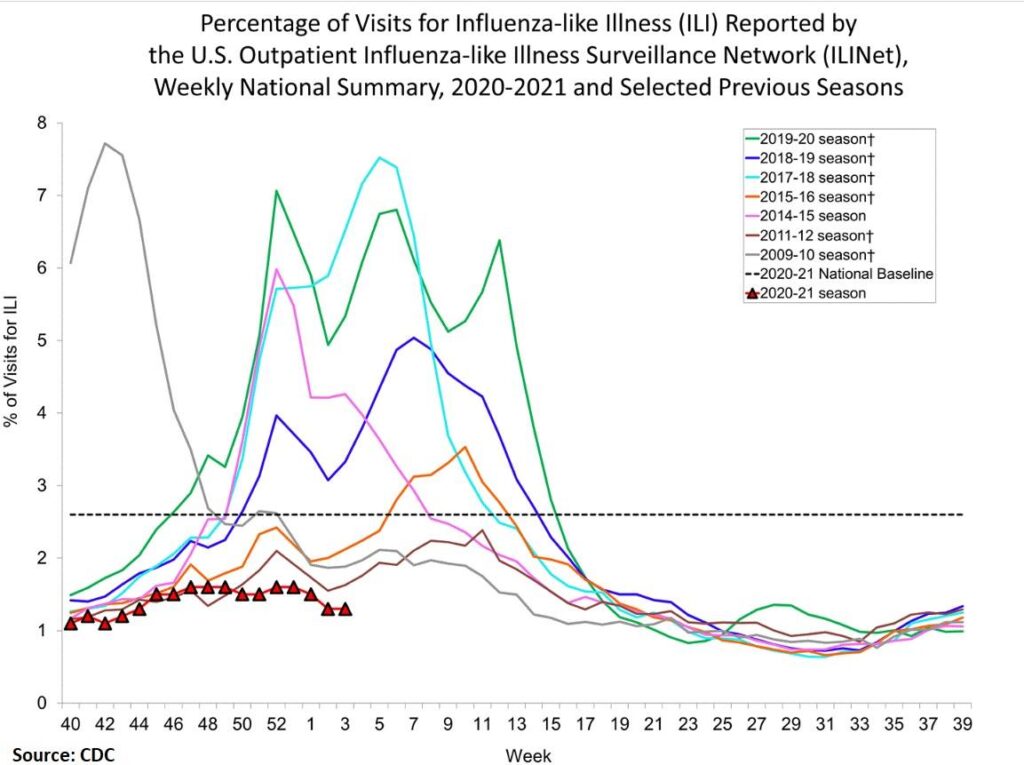A: There has been incredibly low influenza activity this season. Yay!
Turns out, masking, washing hands, staying home when sick, and vaccinations really do work!
Influenza season typically starts around October, peaks between December and February, and then tapers off. And flu is no joke. In the 2019-2020 flu season, the CDC estimated flu caused 38 million illnesses, 18 million medical visits, 405,000 hospitalizations, and 22,000 deaths (195 of which were children) in the US. This season, though, we have seen much less flu than we have in the past. The Influenza Like Illness Surveillance Network (ILINet) reported only 1.3% of patient visits the third week in January were for influenza-like illness, well below the national baseline of 2.6%. There has been only 1 reported pediatric death and only 142 laboratory-confirmed influenza-associated hospitalizations occurring between October 1, 2020, and January 23, 2021.
This all, of course, is great news, but what does it tell us? First, vaccines are important and effective. This year so far, we have had 193.2 million doses of flu vaccine given in the US. This is the highest number of flu vaccine doses ever given in a single season. But we still have room to improve. Vaccine rates went up for adults (53% of adults are vaccinated) but went down for kids and pregnant persons. Disparities persist for vaccine coverage for Black or Hispanic persons compared to white persons. Structural racism, inadequate access, and a lack of strong recommendations from clinicians contribute to these inequities. Flu vaccine (while not perfect) is critical. During the 19-20 flu season, vaccination prevented an estimated 7.5 million influenza illnesses, 105,000 hospitalizations, and 6,300 deaths.
Of course, this flu season was unique as people took extra precautions to avoid Covid19. Influenza is a respiratory virus. Like Covid19, flu can spread on droplets when people cough, sneeze, or even just talk. The virus can infect someone by getting into contact with mucosal surfaces on the mouth or nose or inhaled into the lungs. Steps taken to prevent infection of Covid19 have the added benefit of protecting against the flu as well. Washing hands, wearing masks and staying home when sick all can reduce the spread of influenza.
It is still very possible for flu rates to rise in the coming months so we still need to be on guard. It’s not too late to get your flu shot. Talk with your primary care clinician about checking that to do item off your list. Also, don’t forget to use your SMARTS to protect yourself against Covid19 and the added bonus of protecting against influenza.
↔️Space: Keep your distance from other people.
😷Masks: Keep your nose + mouth covered with a mask that fits well.
💨Air: Keep it fresh.
🏠Restrict: Keep your circle small.
🕑Time: Keep your interactions brief.
💉Shots: Get your vaccine when it’s your turn!
Stay safe. Stay sane. Stay flu free.
Those Nerdy Girls
Links:
CDC Estimates of Flu 2019-2020
CDC Estimates of Flu Vaccine Averted Illness
CDC Weekly Influenza Surveillance
CDC Weekly Flu Vaccination Dashboard



